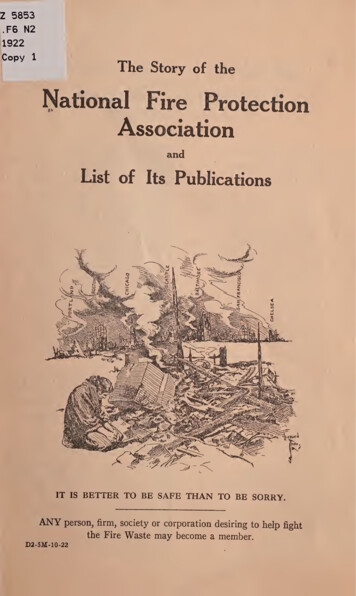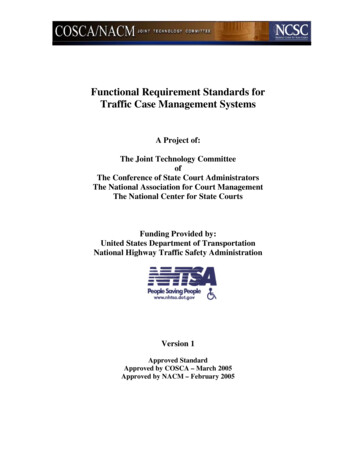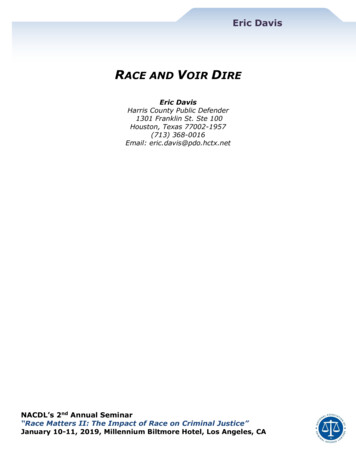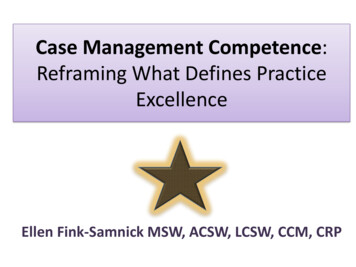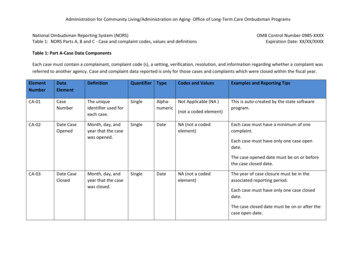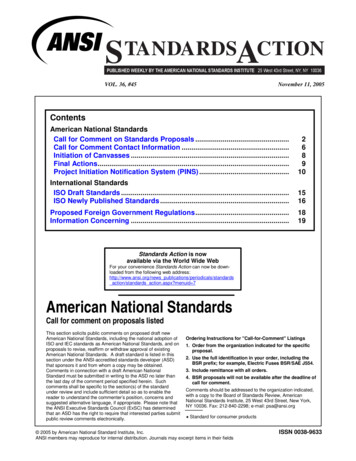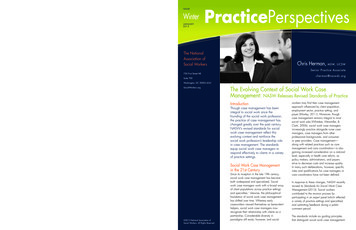
Transcription
ISSUECenter for Workforce Studies & Social Work Practice Recent PublicationsChildren & FamiliesPoverty Social Work Services with Parents: How Attitudes andApproaches Shape the Relationship The Affordable Care Act: Implications for Low andModerate-Income Women’s Health and Well-Being Overcoming Economic ical Social Work 2012 Medicare Updates for Clinical Social WorkersClinical Social Workers and 5010: Frequently Asked QuestionsClinical Social Workers Be Aware: Version 5010 is ComingDocumenting For Medicare: Tips For Clinical Social WorkersRetiring? Tips For Closing Your Private PracticeRisk Management In Clinical PracticeEducation Addressing the Educational Needs of Older Youth Gangs: A Growing Problem in SchoolsLeadership and Organizations Beyond Survival: Ensuring Organizational Sustainability NASW Leadership in Palliative & Hospice Social Work Organizational Integration of Cultural Competency:Building Organizational Capacity to Improve ServiceDelivery to Culturally Diverse Populations Organizing For Office SafetyPractice PerspectivesWinterWorkforce & Career Development Accountable Care Organizations (ACOs): Opportunitiesfor the Social Work Profession Career Coaching: A Valuable Resource For Social Workers Furthering Your Social Work Education: Obtaining A Doctorate Negotiating A Higher Salary Networking: Finding Opportunities for Career Development Securing The Social Work Job You Seek: Advice For TheInterview Process Setting and Maintaining Professional Boundaries State Health Insurance Exchanges: What Social WorkersNeed to Know The Value Of Social Work Mentoring Transitioning Across State Lines: Licensing Tips Beyond9 To 5: Working As A ConsultantThe NationalAssociation ofSocial WorkersChris Herman, M S W, L I C S WSenior Practice Associate750 First Street NEcherman@naswdc.orgSuite 700Washington, DC 20002-4241SocialWorkers.orgThe Evolving Context of Social Work CaseManagement: NASW Releases Revised Standards of PracticeIntroductionThough case management has beenintegral to social work since thefounding of the social work profession,the practice of case management haschanged greatly over the past century.NASW’s revised standards for socialwork case management reflect thisevolving context and reinforce thesocial work profession’s leadership rolein case management. The standardsequip social work case managers torespond effectively to clients in a varietyof practice settings.January 2013750 First Street NE, Suite 700Washington, DC 20002-4241SocialWorkers.orgSocial Work Case Managementin the 21st Century 2013 National Association ofSocial Workers. All Rights Reserved.Since its inception in the late 19th century,social work case management has becomeboth widespread and specialized. Socialwork case managers work with a broad arrayof client populations across practice settingsand specialties.1 Likewise, the philosophicalfoundation of social work case managementhas shifted over time. Whereas earlycaseworkers viewed themselves as benevolenthelpers, social work case managers nowrecognize their relationship with clients as apartnership. Considerable diversity inparadigms still exists, however, and socialworkers may find their case managementapproach influenced by client population,employment sector, practice setting, andpayer (Moxley, 2011). Moreover, thoughcase management remains integral to mostsocial work jobs (Whitaker, Weismiller, &Clark, 2006), social work case managersincreasingly practice alongside nurse casemanagers, case managers from otherprofessional backgrounds, and consumeror peer providers. Case management—along with related practices such as caremanagement and care coordination—is alsogaining increased consideration on a nationallevel, especially in health care reform, aspolicy makers, administrators, and payersstrive to decrease costs and increase quality.In many such deliberations, however, specificroles and qualifications for case managers orcare coordinators have not been defined.In response to these changes, NASW recentlyrevised its Standards for Social Work CaseManagement (2013). Social workerscontributed to the revision process byparticipating in an expert panel (which reflecteda variety of practice settings and specialties)and submitting feedback during a publiccomment period.The standards include six guiding principlesthat distinguish social work case management:
Case managementconstitutes a corefunction of, andspecialty within,social work practice. person-centered services primacy of the client–social workerrelationship2 person-in-environment framework strengths perspective3 collaborative teamwork intervention at the micro, mezzo, and macrolevels (NASW, 2013, p. 17–18).These principles are reflected throughout the 12standards, which address various aspects ofsocial work case management practice.ability. Though already knowledgeable aboutcommunity resources, the case managerimmediately seeks additional information aboutsuch as Medicaid, the Children’s HealthInsurance Program, Temporary Aid to NeedyFamilies, pharmaceutical assistance, Legal Aid,and professional interpretation services. He alsoestablishes a relationship with a local culturalorganization serving immigrants and refugeesand seeks continuing education addressingtrauma related to the refugee experience.CULTURAL AND LINGUISTIC COMPETENCE.Applying the NASW Standardsin PracticeThe following case examples illustrate how theNASW Standards for Social Work CaseManagement (2013) may be applied in practice.ETHICS AND VALUES. An older couple hires ageriatric care manager to help them figure outwhether they can remain in their home or needto relocate. The couple’s adult children contactthe care manager, urging her to move their parentsto a nursing home without delay. They even offerto assume financial responsibility for the caremanagement services if the care manager willcarry out their wishes. The care manager explainsthat she must honor her clients’ wishes and cannotprovide information without their consent. Shediscusses the situation with the couple and offersto facilitate a family meeting to discuss concernsand options. The couple agrees to participate inthe meeting, understanding that their social workerwill support their right to make their own decisions.QUALIFICATIONS. A social worker supervisesthe case managers within a housing agency. Hermanager, the agency administrator, wants to hirea newly graduated MSW who is not yet licensed.The state in which the agency is based licensesMSWs at the graduate level and requires such alicense to practice social work. The social worksupervisor explains to the agency administratorthat the MSW is not able to practice without alicense and that she, as a supervisor, would beputting her own license in jeopardy bysupervising an unlicensed social worker.KNOWLEDGE. A social work case managerleaves a job in a managed care company towork for a community-based health careorganization. Most of his new clients havelimited economic resources; some areundocumented and have limited English-speakingA social work administrator realizes her casemanagement company has few clients whoacknowledge being lesbian, gay, bisexual, ortransgender (LGBT). She convenes a committeeof her colleagues to determine how theorganization can be more welcoming to LGBTclients. The committee revises the company’sintake forms and adds images of same-sexcouples to the organization’s office space andmarketing materials. The social worker invitesa trainer from a local LGBT organization towork with the staff for a day. During the training,one staff member comes out to her colleagues.Other staff members realize ways in which theirbehavior may have alienated LGBT colleaguesand clients, and the entire staff commits toreconvening on a quarterly basis to assess thecompany’s progress in creating an LGBT-affirmingenvironment for both clients and employees.ASSESSMENT. A social work case manager inan adult protective services agency has her firstmeeting with a middle-aged woman referred forsuspected neglect of her chronically ill husband,who needs assistance with several activities ofdaily living. The case manager begins theconversation by explaining that her goal is tosupport the family in coping with the stresses ofillness and caregiving. The woman responds thatshe desperately needs help and is struggling tobalance her full-time job with caring for herhusband. She also acknowledges having felt tooproud to ask for help and not knowing whichservices might be available. The social workeralso talks individually with the man, who expressesconcern about being a burden on his wife andopenness to outside assistance. The case managerobserves to the couple that a great deal ofstrength and mutual caring exists in theirrelationship. She then reflects that the coupleseems to have three main goals: to remain intheir home together, to ensure high-quality carefor the man, and for the woman to be able tocontinue working outside the home. The coupleconcurs, and the three agree to meet again in acouple days to identify steps and resources toachieve those goals.SERVICE PLANNING, DELIVERY, ANDINTERVENTION. A social work case managerin a child and family services agency is workingwith a family displaced by a natural disaster.During the assessment process, the social workerascertains that the family’s goal is to settle in thearea for the remainder of the school year. Thesocial worker intervenes rapidly to address thefamily’s immediate needs for shelter, food, clothing,and health care. She then helps the parentsreestablish communication with family and friendsin their home state, access benefits for disastersurvivors, and connect with job-search resources.The case manager also helps enroll the childrenin the local school, collaborates with the schoolguidance counselor, and arranges for the childrento meet with an art therapist. Moreover, she workswith her agency and neighboring organizationsto determine how to respond effectively to otherdisplaced individuals and families.ADVOCACY AND LEADERSHIP. A social workcase manager works in a rural, consumer-ledorganization for people with disabilities. Sheobserves that many of her clients experiencedifficulty accessing accessible, affordabletransportation options in the community. The socialworker, in collaboration with her colleagues andmembers of the organization’s grassroots advocacynetwork, forms a task force to address the issue.The task force identifies existing transportationresources, communicates recommendations forimprovement to existing transportation vendors,and works with the vendors to educate thecommunity about service options. Given thescarcity of resources available to cover a largearea, the task force develops a plan to seekfunding for a volunteer- and peer-basedtransportation network. The task force alsoidentifies federal, state, and local legislationaddressing accessible transportation, educatesthe organization’s constituents and other potentialallies about the bills, and meets with legislatorsto build support for the legislation.INTERDISCIPLINARY ANDINTERORGANIZATIONAL COLLABORATION.A social work case manager is working with anindividual reentering the community followingincarceration. The case manager obtains hisclient’s permission to communicate with otherprofessionals and organizations—such as aparole officer, county social services office, jobplacement service, and behavioral healthagency—serving the client. The social workerexchanges information with all involved partiesabout the respective roles each plays in supportingthe client’s reentry. He proposes a follow-upconference call, including the client and allinvolved service providers, for the followingmonth to discuss the client’s reentry process.Guiding principles ofsocial work casemanagement:» person-centered services» primacy of the client–social worker relationship» person-in-environmentframeworkPRACTICE EVALUATION AND IMPROVEMENT.A small group of social workers staff a pilot casemanagement program serving veterans. Thesocial workers seek to evaluate the program’ssuccess in helping veterans access resources andtransition from military service to civilian life. Theyuse a variety of methods, including qualitativeclient surveys, validated measures, and programevaluations, to obtain this information. In theprocess, the case managers examine not onlyoutcomes but also the quality and efficiency ofthe case management process. They convey theiraggregated findings to the agency administrator,who uses the data to secure ongoing funding forthe program. The social workers also presenttheir findings at a local conference and coauthora journal article to illustrate the value of socialwork case management in supporting veterans.RECORD KEEPING. A social work case managerworks in an educational setting for teenagerswith behavioral disorders. She maintainsaccurate, timely documentation and other recordsin a secure database. Her documentation reflectseach student’s evolving goals and ongoingparticipation in the case management process.Because some of her clients are involved inthe foster care system, the court occasionallysubpoenas the social worker’s records. The socialworker explains this limitation on confidentiality toeach client at the beginning of service anddocuments that such communication has takenplace. When the social worker receives asubpoena for her records, she consults hersupervisor and reviews her employer’s policy forrelease of records. The case manager releasesonly the information requested by the court.WORKLOAD SUSTAINABILITY. When newmanagement takes over a mental health agency,both caseloads and documentation requirementsincrease. Over the course of a year, one social» strengths perspective» collaborative teamwork» intervention at the micro,mezzo, and macro levels(NASW, 2013, p. 17–18).
Case managementconstitutes a corefunction of, andspecialty within,social work practice. person-centered services primacy of the client–social workerrelationship2 person-in-environment framework strengths perspective3 collaborative teamwork intervention at the micro, mezzo, and macrolevels (NASW, 2013, p. 17–18).These principles are reflected throughout the 12standards, which address various aspects ofsocial work case management practice.ability. Though already knowledgeable aboutcommunity resources, the case managerimmediately seeks additional information aboutsuch as Medicaid, the Children’s HealthInsurance Program, Temporary Aid to NeedyFamilies, pharmaceutical assistance, Legal Aid,and professional interpretation services. He alsoestablishes a relationship with a local culturalorganization serving immigrants and refugeesand seeks continuing education addressingtrauma related to the refugee experience.CULTURAL AND LINGUISTIC COMPETENCE.Applying the NASW Standardsin PracticeThe following case examples illustrate how theNASW Standards for Social Work CaseManagement (2013) may be applied in practice.ETHICS AND VALUES. An older couple hires ageriatric care manager to help them figure outwhether they can remain in their home or needto relocate. The couple’s adult children contactthe care manager, urging her to move their parentsto a nursing home without delay. They even offerto assume financial responsibility for the caremanagement services if the care manager willcarry out their wishes. The care manager explainsthat she must honor her clients’ wishes and cannotprovide information without their consent. Shediscusses the situation with the couple and offersto facilitate a family meeting to discuss concernsand options. The couple agrees to participate inthe meeting, understanding that their social workerwill support their right to make their own decisions.QUALIFICATIONS. A social worker supervisesthe case managers within a housing agency. Hermanager, the agency administrator, wants to hirea newly graduated MSW who is not yet licensed.The state in which the agency is based licensesMSWs at the graduate level and requires such alicense to practice social work. The social worksupervisor explains to the agency administratorthat the MSW is not able to practice without alicense and that she, as a supervisor, would beputting her own license in jeopardy bysupervising an unlicensed social worker.KNOWLEDGE. A social work case managerleaves a job in a managed care company towork for a community-based health careorganization. Most of his new clients havelimited economic resources; some areundocumented and have limited English-speakingA social work administrator realizes her casemanagement company has few clients whoacknowledge being lesbian, gay, bisexual, ortransgender (LGBT). She convenes a committeeof her colleagues to determine how theorganization can be more welcoming to LGBTclients. The committee revises the company’sintake forms and adds images of same-sexcouples to the organization’s office space andmarketing materials. The social worker invitesa trainer from a local LGBT organization towork with the staff for a day. During the training,one staff member comes out to her colleagues.Other staff members realize ways in which theirbehavior may have alienated LGBT colleaguesand clients, and the entire staff commits toreconvening on a quarterly basis to assess thecompany’s progress in creating an LGBT-affirmingenvironment for both clients and employees.ASSESSMENT. A social work case manager inan adult protective services agency has her firstmeeting with a middle-aged woman referred forsuspected neglect of her chronically ill husband,who needs assistance with several activities ofdaily living. The case manager begins theconversation by explaining that her goal is tosupport the family in coping with the stresses ofillness and caregiving. The woman responds thatshe desperately needs help and is struggling tobalance her full-time job with caring for herhusband. She also acknowledges having felt tooproud to ask for help and not knowing whichservices might be available. The social workeralso talks individually with the man, who expressesconcern about being a burden on his wife andopenness to outside assistance. The case managerobserves to the couple that a great deal ofstrength and mutual caring exists in theirrelationship. She then reflects that the coupleseems to have three main goals: to remain intheir home together, to ensure high-quality carefor the man, and for the woman to be able tocontinue working outside the home. The coupleconcurs, and the three agree to meet again in acouple days to identify steps and resources toachieve those goals.SERVICE PLANNING, DELIVERY, ANDINTERVENTION. A social work case managerin a child and family services agency is workingwith a family displaced by a natural disaster.During the assessment process, the social workerascertains that the family’s goal is to settle in thearea for the remainder of the school year. Thesocial worker intervenes rapidly to address thefamily’s immediate needs for shelter, food, clothing,and health care. She then helps the parentsreestablish communication with family and friendsin their home state, access benefits for disastersurvivors, and connect with job-search resources.The case manager also helps enroll the childrenin the local school, collaborates with the schoolguidance counselor, and arranges for the childrento meet with an art therapist. Moreover, she workswith her agency and neighboring organizationsto determine how to respond effectively to otherdisplaced individuals and families.ADVOCACY AND LEADERSHIP. A social workcase manager works in a rural, consumer-ledorganization for people with disabilities. Sheobserves that many of her clients experiencedifficulty accessing accessible, affordabletransportation options in the community. The socialworker, in collaboration with her colleagues andmembers of the organization’s grassroots advocacynetwork, forms a task force to address the issue.The task force identifies existing transportationresources, communicates recommendations forimprovement to existing transportation vendors,and works with the vendors to educate thecommunity about service options. Given thescarcity of resources available to cover a largearea, the task force develops a plan to seekfunding for a volunteer- and peer-basedtransportation network. The task force alsoidentifies federal, state, and local legislationaddressing accessible transportation, educatesthe organization’s constituents and other potentialallies about the bills, and meets with legislatorsto build support for the legislation.INTERDISCIPLINARY ANDINTERORGANIZATIONAL COLLABORATION.A social work case manager is working with anindividual reentering the community followingincarceration. The case manager obtains hisclient’s permission to communicate with otherprofessionals and organizations—such as aparole officer, county social services office, jobplacement service, and behavioral healthagency—serving the client. The social workerexchanges information with all involved partiesabout the respective roles each plays in supportingthe client’s reentry. He proposes a follow-upconference call, including the client and allinvolved service providers, for the followingmonth to discuss the client’s reentry process.Guiding principles ofsocial work casemanagement:» person-centered services» primacy of the client–social worker relationship» person-in-environmentframeworkPRACTICE EVALUATION AND IMPROVEMENT.A small group of social workers staff a pilot casemanagement program serving veterans. Thesocial workers seek to evaluate the program’ssuccess in helping veterans access resources andtransition from military service to civilian life. Theyuse a variety of methods, including qualitativeclient surveys, validated measures, and programevaluations, to obtain this information. In theprocess, the case managers examine not onlyoutcomes but also the quality and efficiency ofthe case management process. They convey theiraggregated findings to the agency administrator,who uses the data to secure ongoing funding forthe program. The social workers also presenttheir findings at a local conference and coauthora journal article to illustrate the value of socialwork case management in supporting veterans.RECORD KEEPING. A social work case managerworks in an educational setting for teenagerswith behavioral disorders. She maintainsaccurate, timely documentation and other recordsin a secure database. Her documentation reflectseach student’s evolving goals and ongoingparticipation in the case management process.Because some of her clients are involved inthe foster care system, the court occasionallysubpoenas the social worker’s records. The socialworker explains this limitation on confidentiality toeach client at the beginning of service anddocuments that such communication has takenplace. When the social worker receives asubpoena for her records, she consults hersupervisor and reviews her employer’s policy forrelease of records. The case manager releasesonly the information requested by the court.WORKLOAD SUSTAINABILITY. When newmanagement takes over a mental health agency,both caseloads and documentation requirementsincrease. Over the course of a year, one social» strengths perspective» collaborative teamwork» intervention at the micro,mezzo, and macro levels(NASW, 2013, p. 17–18).
Case ManagementStatistics fromNASW’s Study ofLicensed SocialWorkers in the U.S. Case management is one ofonly four tasks on whichsignificant numbers of licensedsocial workers report spendingmore than half their time(Whitaker, Weismiller, &Clark, 2006a, p. 19). Case management agenciesare among the most commonpractice settings forgerontological social workers.Social work caseloads of 50clients or more are commonin case management agenciesserving older adults (Whitaker,Weismiller, & Clark, 2006b,pp. 22 & 24). Among social workers inhealth care settings, 70%spend at least some time oncase management, and 15%spend more than half theirtime on case management.Social workers in bothhospitals and health clinicsrank case managementamong the top five tasks towhich they devote time onthe job (Whitaker, Weismiller,Clark, & Wilson, 2006,pp. 13–14).work case manager struggles to provide herusual quality of service to her clients, many ofwhom live with schizophrenia. Her colleaguesreport similar experiences. The social workerrequests a meeting with her supervisor to discussher concern. During that meeting, the casemanager identifies the most time-intensivefunctions of her job, describes how the growingcaseload size and documentation requirementshave affected service quality, and conveysanecdotal information she has gathered aboutcaseload sizes in similar programs. She reiteratesher commitment to the agency’s mission andrequests her supervisor’s assistance in decreasingcaseload size. The supervisor, who is also asocial worker, schedules a meeting with the entirecase management staff to discuss the department’sworkload. Following the meeting, the supervisorapproaches the agency administrator andadvocates that an additional case manager behired to ensure high-quality service. She alsoproposes, and offers to chair, an internal taskforce to develop policies for determining andmaintaining caseload size. The task force, whichincludes direct practice employees, incorporatesin its recommendations data from both theagency’s own program evaluations and theprofessional literature.4, 5ConclusionCase management constitutes a core function of,and specialty within, social work practice. Socialwork case management has evolved, and willcontinue to grow, in response to changes in bothpractice and policy. The NASW Standards forSocial Work Case Management (2013) exemplifythese changes, highlighting the principles andelements integral to social work case managementacross client populations and practice settings.Visit anagementStandards2013.pdfto download and print the NASW Standards forSocial Work Case Management. Single copiesor bulk orders are available from the NASWPress ml).12PROFESSIONAL DEVELOPMENT ANDCOMPETENCE. A social work case managerwith a decade of experience in HIV/AIDS workis qualified to practice without supervision butparticipates in ongoing continuing education andseeks supervision or consultation as needed. Shehas a growing number of clients who are AmericanIndian or Alaska Native. The social worker haslittle experience with these groups and recognizesshe needs to boost her knowledge and skills. Sheturns to the social work literature and also seeksinformation from reliable sources, such as theIndian Health Service, the Centers for DiseaseControl and Prevention, and the National Institutesof Health. The case manager also enrolls, withsupport from her employer, in a continuingeducation course on culturally competent practicewith American Indians and Alaska Natives(AI/AN). This course links her with other socialworkers with personal or professional interest andexperience in the topic. The social worker joins anetwork devoted to improving AI/AN health careand, over time and in collaboration with hernetwork colleagues, becomes a trusted resource onthe topic both within and beyond her organization.See, for example, Austin & McClelland, 2009; Berger,2009; Giddens, Ka‘opua, & Tomaszewski, 2009;Lightfoot, 2009; Mather & Hull, 2009; Moxley, 2009;Rapp, 2009; Ritter, Vakalahi, & Kiernan-Stern, 2009;Sullivan, 2009; Vanderplasschen, Wolf, Rapp &Broekart, 2007; and Walsh, 2009.Resources addressing the client–social work casemanager relationship include Stanhope & Solomon’s2009 publication on the consumer-provider relationshipand Kondrat & Early’s 2010 article on the workingalliance in mental health case management.3Articles by C. A. Rapp (2008), R. C. Rapp (2007),and Sullivan (2009) expand on strengths-basedcase management.4Social work case managers may find the CaseManagement Caseload Concept Paper, published jointlyby the NASW and the Case Management Society ofAmerica and NASW (Craig & Stanton, 2008), useful indeliberations regarding caseload and workload inhealth, behavioral health, and compensation settings.The Caseload Capacity Calculator (CLC), which buildson both the 2008 NASW–CMSA concept paper and a2011 survey of NASW members, may also be useful tosocial workers working within health plans or in acute,inpatient hospitals. The CLC software, developed byConsulting Management Innovators, Inc. (CMI) andavailable free of charge at www.socialworkers.org/caseloadcalculator, allows users to downloadcomparison data regarding caseload ratios of casemanagers in similar settings. The software does not,however, identify recommended caseload ratios.5Social worker self-care, addressed in the ethics sectionof the revised case management standards, may alsobe affected by an unsustainable workload. Please referto NASW’s policy statements addressing professionalself-care (2012a) and professional impairment (2012b)for additional information. See also the NASW Centerfor Workforce Studies report, Stress at Work: How DoSocial Workers Cope? (Arrington, 2008).ReferencesArrington, P. (2008). Stress at work: How do socialworkers cope? [NASW membership workforce study].Retrieved from National Association of Social Workerswebsite: .pdfAustin, C. D., & McClelland, R. W. (2009). Casemanagement with older adults. In A. R. Roberts(Ed.-in-Chief), Social workers’ desk reference(2nd ed., pp. 796–801). New York: OxfordUniversity Press.Berger, C. S. (2009). Social work case managementin medical settings. In A. R. Roberts (Ed.-in-Chief),Social workers’ desk reference (2nd ed., pp.790–796). New York: Oxford University Press.Craig, K., & Stanton, M. (Eds.). (2008). Casemanagement caseload concept paper: Proceedingsof the Caseload Work Group, a joint collaborationof CMSA and NASW. Retrieved from NationalAssociation of Social Work
the practice of case management has changed greatly over the past century. NASW's revised standards for social work case management reflect this evolving context and reinforce the social work profession's leadership role in case management. The standards equip social work case managers to respond effectively to clients in a variety of .

